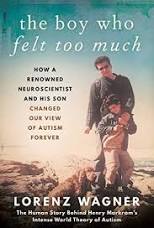Lorenz Wagner writes about a neuroscientist, Henry Markram and his son, Kai, who have contributed to a new understanding of what autism is. Henry Markram is currently involved in the Blue Brain Project which is trying to create a digital simulation of the human brain. One of the purposes of the project is to try to understand better how the brain functions so that we can better understand such conditions as autism. Kai has autism. Having a son who reacts to the world differently lead Henry Markram to want to understand better how the brain functions in such people.

In addition, Henry Markram, Tania Rinaldi and Kamila Markram have published an article about the results of some research, The Intense World Syndrome – An Alternative Hypothesis of Autism. To put their hypothesis in simple terms, some people react too much to the environment around them and this can make their life difficult.
“… excessive neuronal processing may render the world painfully intense when the neocortex is affected and even aversive when the amygdala is affected, leading to social and environmental withdrawal. Excessive neuronal learning is also hypothesized to rapidly lock down the individual into a small repertoire of secure behavioral routines that are obsessively repeated.”
Reading the book by Lorenz Wagner has given me a different understanding of autism and Asperger’s syndrome. I first read about Asperger’s syndrome because I was going to teach a pupil with this diagnosis. It was scary because everything on the list applied to me as well, even though I was a functioning adult with a job as a teacher. Today it is often referred to as being “on the spectrum” because every person who has autism or been diagnosed with Asperger’s syndrome is very different. Some have more severe reactions due to this neural processing, some have less severe reactions and many have learned how to cope with the way they have been put together.
One of the main things I have gotten out of reading Wagner’s book is a better empathy for those who have this ultra-sensitive reaction to the stimulus that we all receive in our daily lives. We are all built differently and we have to accept how others are, without wanting to change them. Though autism is considered a “disorder” (autism spectrum disorder or ASD), it is, in my opinion, just a different way of reacting to a world filled with a lot of action, sound and light stimulation. For some people, there is just too much to make life comfortable.
Everyone has their own way of coping with the stresses of the real world. Those who have been labeled as having autism also have to cope with the label they have been given.
I would recommend reading this book to anyone who has a family member who has autism or who comes into contact with those who have been diagnosed with Asperger’s syndrome. It may give some insights into how they see the world and why they are the way they are.
